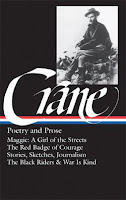From The Civil War: The Final Year Told by Those Who Lived It
Interesting Links
“Did My Great-Grandfather Beat Robert E. Lee?” (Paul Donnelly, The New York Times)
“Lincoln’s Visit to Richmond” (National Park Service)
Previous Story of the Week selections
• “Union Looters” (December 1865), Mary S. Mallard
• “Our Visit to Richmond” (July 1864), James R. Gilmore
Buy the book
.jpg) The Civil War: The Final Year Told by Those Who Lived It
The Civil War: The Final Year Told by Those Who Lived It
160 pieces • over 100 participants • 886 pages
List price: $40.00
Save 20%, free shipping
Web Store price: $32.00
Available as a boxed set
The Civil War Told by Those Who Lived It
Four volumes • 3,624 pages
“Did My Great-Grandfather Beat Robert E. Lee?” (Paul Donnelly, The New York Times)
“Lincoln’s Visit to Richmond” (National Park Service)
Previous Story of the Week selections
• “Union Looters” (December 1865), Mary S. Mallard
• “Our Visit to Richmond” (July 1864), James R. Gilmore
Buy the book
.jpg) The Civil War: The Final Year Told by Those Who Lived It
The Civil War: The Final Year Told by Those Who Lived It160 pieces • over 100 participants • 886 pages
List price: $40.00
Save 20%, free shipping
Web Store price: $32.00
Available as a boxed set
The Civil War Told by Those Who Lived It
Four volumes • 3,624 pages
 |
| “Ruins of Richmond, VA, 1865,” by photographer Mathew Brady (1822–1896). National Archives and Records Administration, College Park. Wikimedia Commons. |
The defeat marked the beginning of the end of the Civil War. After heavy fighting on March 31, Union forces advanced on Five Forks, a crossroads about twelve miles southwest of Petersburg defended by a force of 10,000 under Major General George E. Pickett, who had been ordered by Lee to hold the position “at all hazards.” On the afternoon of April 1 the Union Army broke the Confederate lines at Five Forks. General Ulysses S. Grant then ordered an assault on the Petersburg defenses at dawn on Sunday, April 2. Within hours Lee telegraphed the Confederate War Department that both Petersburg and Richmond would have to be abandoned that night.
It is with Jefferson Davis’s receipt of that message that Sallie Brock begins the following account, which describes the fall of Richmond—and the devastation caused entirely by the actions of the fleeing Confederate military. After a triumphant entry, Union soldiers struggled to put out the fires, but it is clear from accounts that the conflagration was far too widespread—and the damage was already far too extensive—for any effort to save much of the city. On Tuesday, April 4, President Lincoln ignored the concerns for his safety and entered Richmond with his son Tad to meet with Union leaders, speak with the residents, and survey the damage.
In a later chapter of her account Brock describes the effects of the city’s destruction on the population:
The miseries of our situation which would have been incalculable at best were inconceivably enhanced by the disastrous burning of the business portion of the city. Nearly all the supplies of food were kept in the stores which were consumed by the fire and our poor people were almost totally dependent upon the mercy of the captors. For several months no remunerative employment could be obtained by the masses and they were compelled to live by charity.Born in Madison County, Virginia, Brock had moved with her family to Richmond in 1858. In early 1861 she was working as a tutor about fifty miles away, in King and Queen County, but returned to Richmond when the war began and remained there for its duration. After the fall of Richmond she moved to New York City and two years later anonymously published her account of the war, which has remained in print for most of the past century and a half. In 1873 she published a poorly received (and soon forgotten) novel, Kenneth, My King, described by one recent scholar as “four hundred pages of courtship.” In 1882 Brock briefly returned to Virginia to marry Richard Putnam, an Episcopal minister from Boston. The couple lived in Brooklyn for the rest of their lives, but both were buried in Richmond.
Notes: The footnote on page 643 refers to the marriage of Lieutenant Colonel Walter H. Taylor, an assistant adjutant general on General Lee’s staff, to Ellen Selden Saunders. A receiving ship (p. 644) is a vessel where new recruits were sent to await service assignments. The “long lines of negro cavalry” (p. 646) were members of the 5th Massachusetts Cavalry, commanded by Colonel Charles Francis Adams Jr. The “morbidly sensitive clause” mocked on the last page was included in General George Shepley’s order of April 3: “No treasonable or offensive expressions insulting the flag, the cause or the armies of the Union will hereafter be allowed.”
* * *
The morning of the 2d of April, 1865, dawned brightly over the capital of the Southern Confederacy. A soft haze rested over the city, but above that, the sun shone with the warm pleasant radiance of early spring. . . . If you don't see the full selection below, click here (PDF) or click here (Google Docs) to read it—free!This selection may be photocopied and distributed for classroom or educational use.







